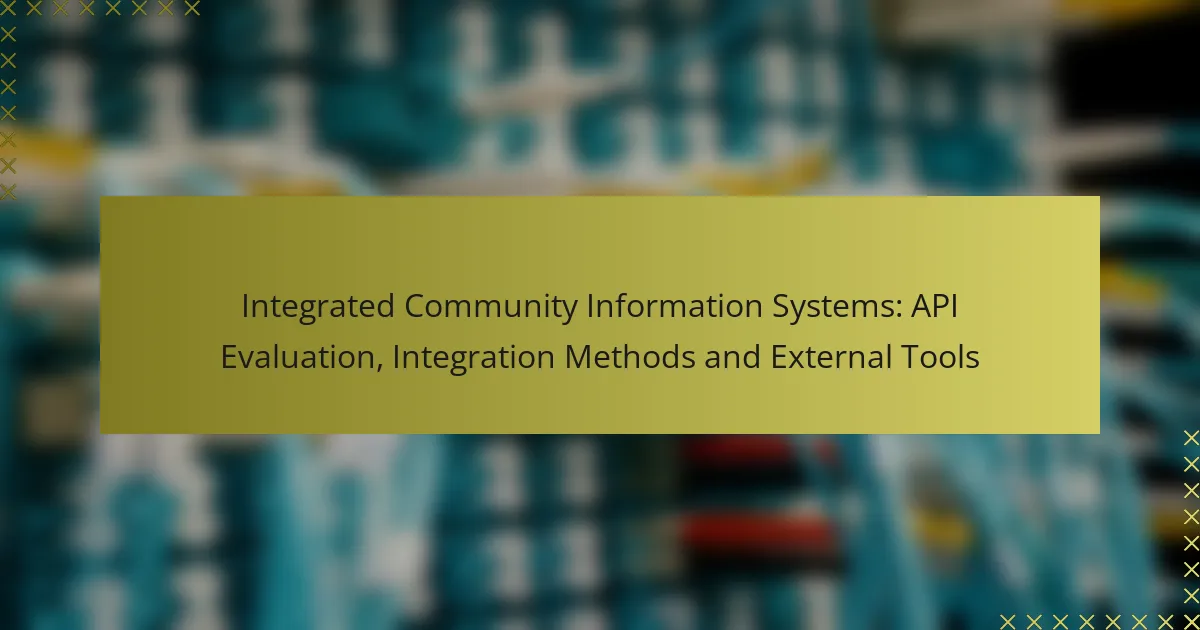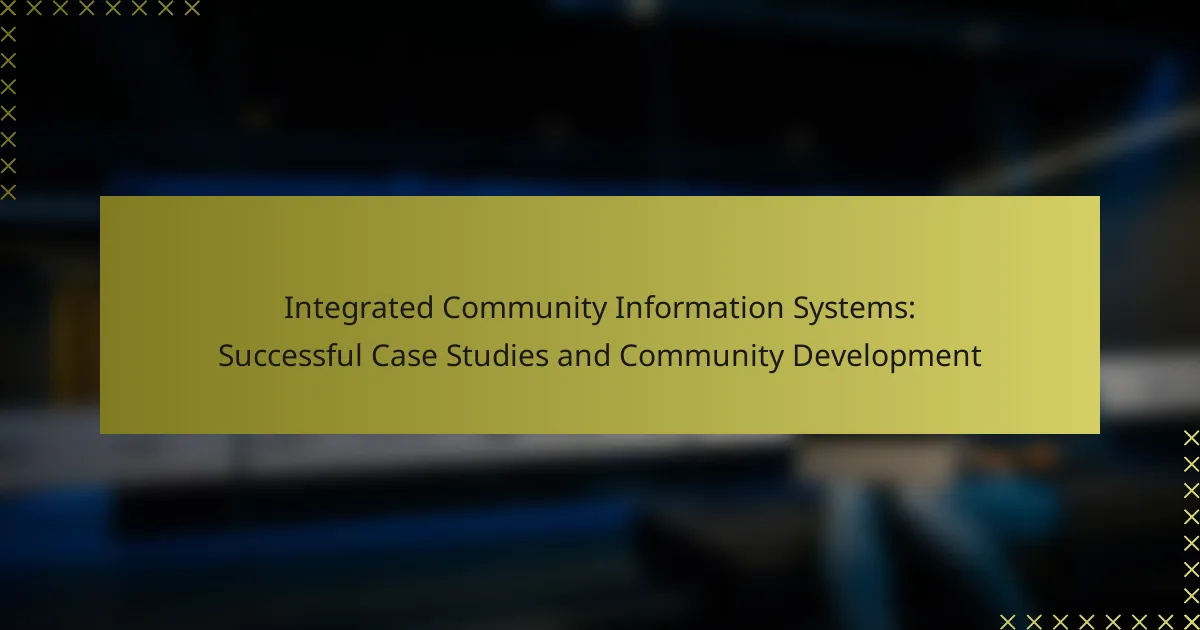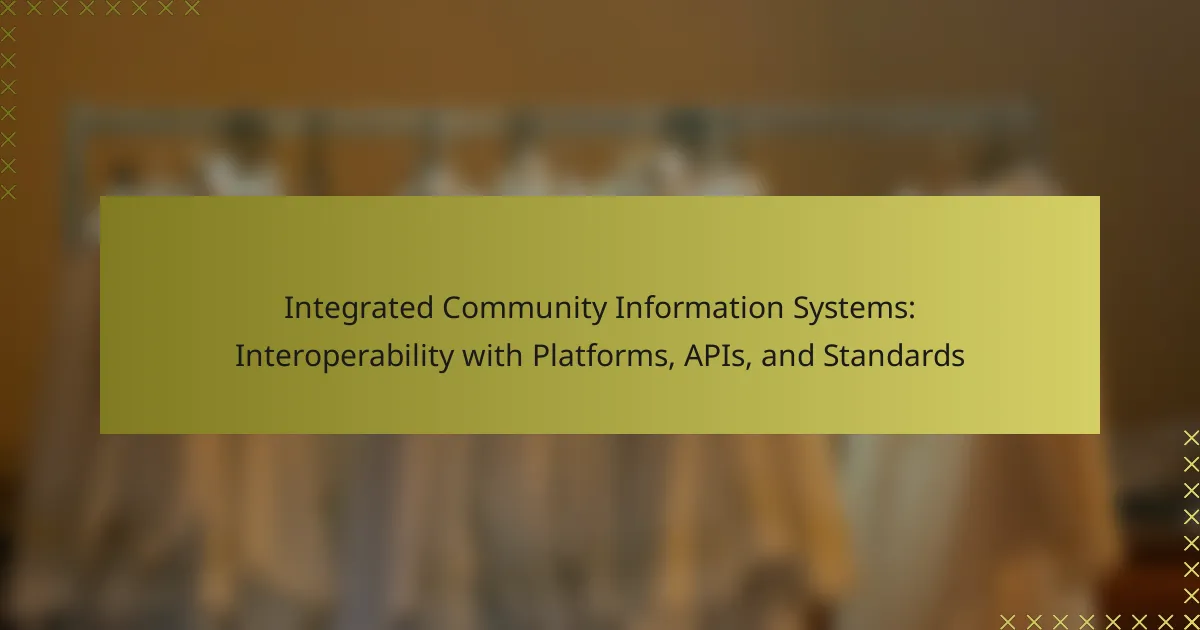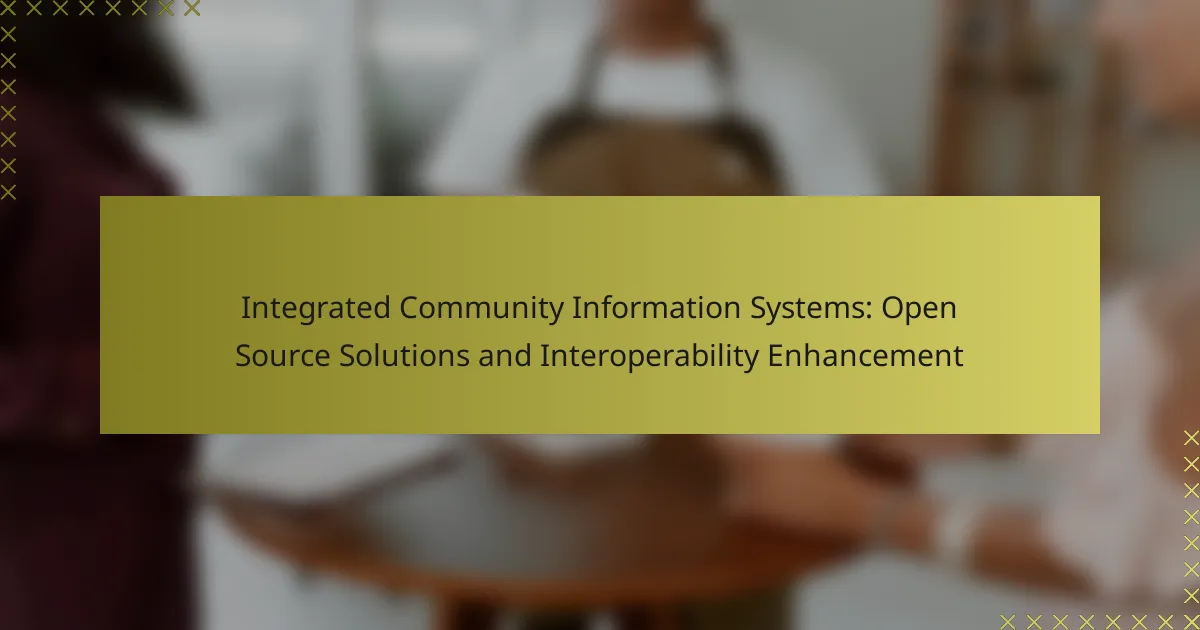Integrated Community Information Systems (ICIS) play a crucial role in enhancing information sharing and service delivery within communities. Effective API evaluation methods, such as RESTful, GraphQL, and SOAP, are essential for assessing functionality, performance, and security. Additionally, various integration methods and external tools can further optimize these systems by enabling automation, data visualization, and analytics, ultimately improving decision-making and community engagement.
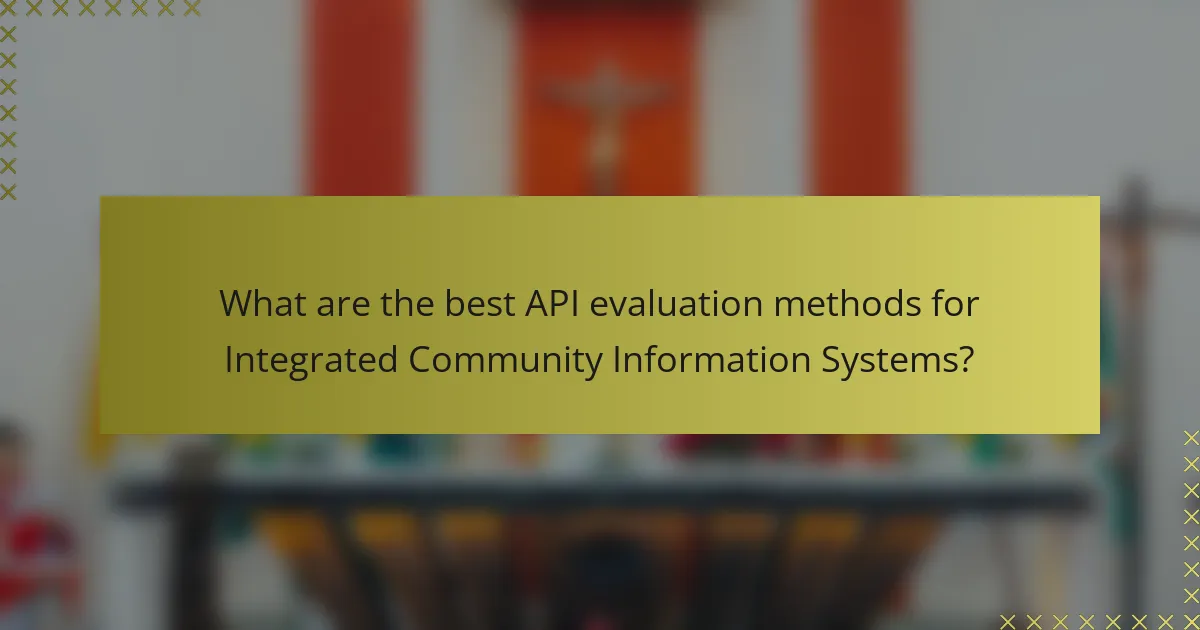
What are the best API evaluation methods for Integrated Community Information Systems?
The best API evaluation methods for Integrated Community Information Systems focus on assessing functionality, performance, and security. Key methods include RESTful, GraphQL, and SOAP evaluations, each providing unique advantages and considerations for integration.
RESTful API evaluation
RESTful APIs are widely used due to their simplicity and scalability. When evaluating a RESTful API, consider factors such as response time, data format (typically JSON), and adherence to REST principles like statelessness and resource-based URLs.
Key performance metrics include latency, throughput, and error rates. A well-performing RESTful API should respond in low tens of milliseconds under normal load conditions.
GraphQL API evaluation
GraphQL APIs allow clients to request specific data, reducing over-fetching and under-fetching issues. When evaluating a GraphQL API, focus on its schema design, query complexity, and response times.
Common evaluation criteria include the ability to handle nested queries efficiently and the performance impact of complex queries. A good GraphQL API should maintain response times within single-digit milliseconds for standard queries.
SOAP API evaluation
SOAP APIs are known for their strict standards and built-in security features. Evaluating a SOAP API involves examining its WSDL (Web Services Description Language) file, which defines the service’s operations and message formats.
Consider the API’s support for WS-Security, transaction management, and error handling. SOAP APIs typically have higher overhead than RESTful APIs, so response times may range from low hundreds of milliseconds to several seconds depending on the complexity of the operations.
Comparative analysis of API performance
Comparative analysis involves benchmarking different APIs against each other based on key performance indicators. Metrics to consider include response times, error rates, and throughput under load.
Using tools like Postman or JMeter can help automate testing and provide insights into performance differences. Establish a baseline for acceptable performance and compare each API’s results against it to identify the best fit for your needs.
Security assessment of APIs
Security is critical when evaluating APIs, particularly for community information systems that handle sensitive data. Assess APIs for common vulnerabilities such as SQL injection, cross-site scripting, and improper authentication mechanisms.
Implement security best practices, including using HTTPS, validating input, and employing OAuth for authorization. Regular security audits and penetration testing can help identify and mitigate potential risks effectively.
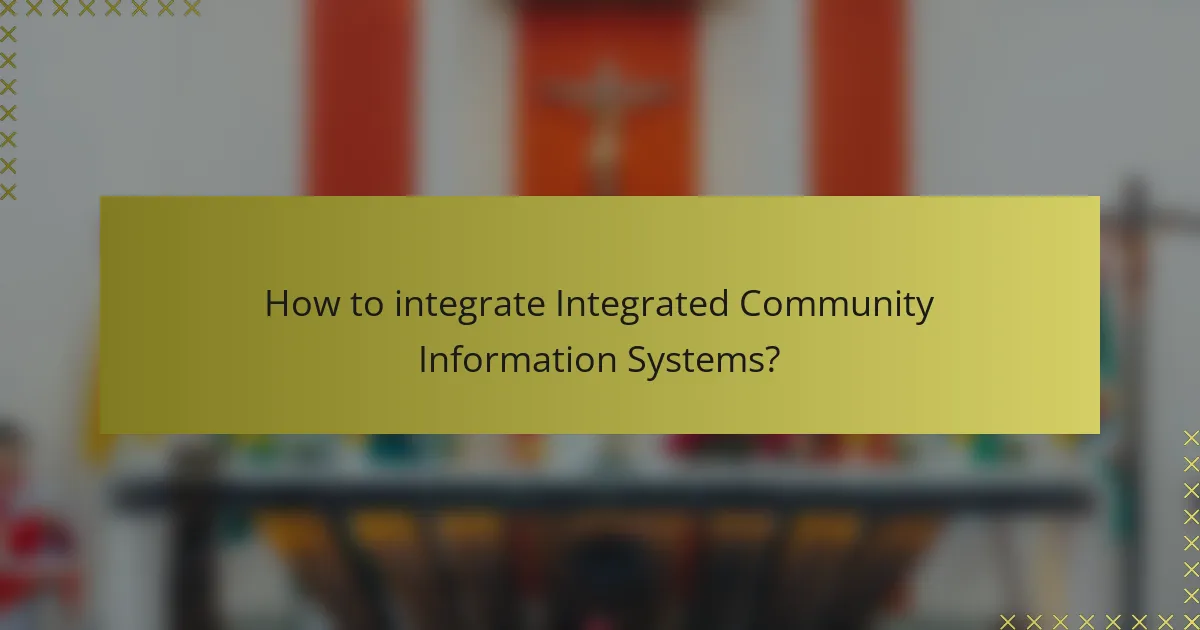
How to integrate Integrated Community Information Systems?
Integrating Integrated Community Information Systems (ICIS) involves connecting various data sources and applications to streamline information sharing and improve service delivery. Key methods include middleware integration, direct API connections, data synchronization, and utilizing cloud-based platforms.
Middleware integration techniques
Middleware integration techniques serve as intermediaries that facilitate communication between different systems. These tools can handle data transformation, protocol conversion, and message routing, making it easier to connect disparate applications.
Common middleware solutions include Enterprise Service Buses (ESBs) and Message Queues. They allow for scalable integration, enabling organizations to add or modify services without disrupting existing workflows.
Direct API integration methods
Direct API integration methods involve using application programming interfaces to connect systems directly. This approach allows for real-time data exchange and can be more efficient than middleware solutions.
When implementing direct API integrations, consider RESTful APIs for their simplicity and wide adoption. Ensure that proper authentication and security measures, such as OAuth, are in place to protect sensitive information.
Data synchronization strategies
Data synchronization strategies ensure that information remains consistent across integrated systems. This can be achieved through batch processing, real-time updates, or event-driven architectures.
Choose a synchronization method based on the frequency of data changes and the criticality of real-time access. For instance, real-time synchronization is essential for applications requiring immediate updates, while batch processing may suffice for less time-sensitive data.
Cloud-based integration platforms
Cloud-based integration platforms offer a flexible and scalable solution for integrating ICIS. These platforms provide pre-built connectors and tools to streamline the integration process, reducing the need for extensive coding.
Popular cloud-based platforms include MuleSoft, Zapier, and Microsoft Azure Logic Apps. They often come with subscription-based pricing, making them accessible for organizations of various sizes. Evaluate the platform’s compatibility with existing systems and its ability to handle expected data volumes before committing.

What external tools enhance Integrated Community Information Systems?
External tools significantly improve the functionality of Integrated Community Information Systems (ICIS) by facilitating automation, data visualization, customer relationship management, and analytics. These tools streamline processes, enhance decision-making, and provide valuable insights into community data.
Zapier for automation
Zapier automates workflows between various applications, allowing Integrated Community Information Systems to connect with numerous external services without extensive coding. By setting up “Zaps,” users can automate repetitive tasks, such as updating records or sending notifications, which saves time and reduces errors.
For example, a community organization can automatically add new contacts from a web form to their ICIS or trigger alerts when specific data is updated. This integration can enhance operational efficiency and ensure timely communication with stakeholders.
Tableau for data visualization
Tableau transforms complex data from Integrated Community Information Systems into interactive visualizations, making it easier to analyze and understand community trends. Users can create dashboards that display key metrics, helping decision-makers quickly grasp insights and identify patterns.
For instance, a community health department might use Tableau to visualize vaccination rates across different neighborhoods, enabling targeted outreach efforts. The tool supports various data sources, allowing seamless integration with existing systems.
Salesforce for CRM integration
Salesforce enhances Integrated Community Information Systems by providing robust customer relationship management (CRM) capabilities. This integration allows organizations to track interactions with community members, manage cases, and streamline communication efforts.
By leveraging Salesforce, a nonprofit can maintain detailed records of client interactions and follow up on services provided, ensuring no one falls through the cracks. This integration can lead to improved service delivery and stronger community relationships.
Microsoft Power BI for analytics
Microsoft Power BI offers powerful analytics tools that can be integrated with Integrated Community Information Systems to provide in-depth data analysis and reporting. Users can create custom reports that help visualize performance metrics and track progress toward community goals.
For example, a local government can utilize Power BI to analyze service usage trends and allocate resources more effectively. The ability to share insights across departments fosters collaboration and informed decision-making.

What are the key criteria for selecting an API for community systems?
When selecting an API for community systems, key criteria include scalability, documentation quality, and community support. These factors ensure that the API can grow with your needs, is easy to understand, and has a robust support network for troubleshooting and enhancements.
Scalability of the API
Scalability refers to the API’s ability to handle increased loads without performance degradation. An ideal API should accommodate growth in user numbers and data volume, often measured in requests per second or data throughput. Look for APIs that can scale horizontally, allowing you to add more resources as demand increases.
Consider APIs that offer tiered pricing models based on usage, which can help manage costs as your community grows. Evaluate whether the API can maintain performance during peak usage times, which is crucial for community engagement.
Documentation quality
High-quality documentation is essential for effective API integration. It should provide clear, concise instructions, code examples, and use cases that help developers understand how to implement the API efficiently. Look for comprehensive guides that cover authentication, endpoints, and error handling.
Good documentation often includes interactive tools or sandbox environments where developers can test API calls. Ensure that the documentation is regularly updated to reflect changes in the API, as outdated information can lead to integration issues.
Community support and resources
A strong community around an API can significantly enhance its usability. Look for APIs that have active forums, user groups, or dedicated support channels where developers can ask questions and share solutions. This support can be invaluable when facing integration challenges.
Additionally, check for available resources such as tutorials, webinars, and sample projects that can accelerate the learning curve. A vibrant community often indicates a well-supported API, which can lead to more reliable and innovative solutions for your community systems.

What are the emerging trends in Integrated Community Information Systems?
Emerging trends in Integrated Community Information Systems (ICIS) focus on enhancing data utilization and ensuring user privacy. These trends include the adoption of AI technologies for data analysis and a heightened emphasis on data protection regulations.
AI-driven data analysis
AI-driven data analysis is transforming how Integrated Community Information Systems process and interpret vast amounts of data. By leveraging machine learning algorithms, these systems can identify patterns and insights that would be difficult for humans to discern.
For instance, predictive analytics can help communities anticipate service demands, allowing for more efficient resource allocation. Organizations should consider integrating AI tools that align with their specific data needs and operational goals to maximize benefits.
Increased focus on data privacy
With the rise of data breaches and privacy concerns, there is an increased focus on data privacy within Integrated Community Information Systems. Regulations such as GDPR in Europe and CCPA in California mandate strict guidelines for data handling and user consent.
Communities must implement robust data protection measures, including encryption and access controls, to safeguard sensitive information. Regular audits and training for staff on data privacy practices are essential to ensure compliance and build trust with users.
